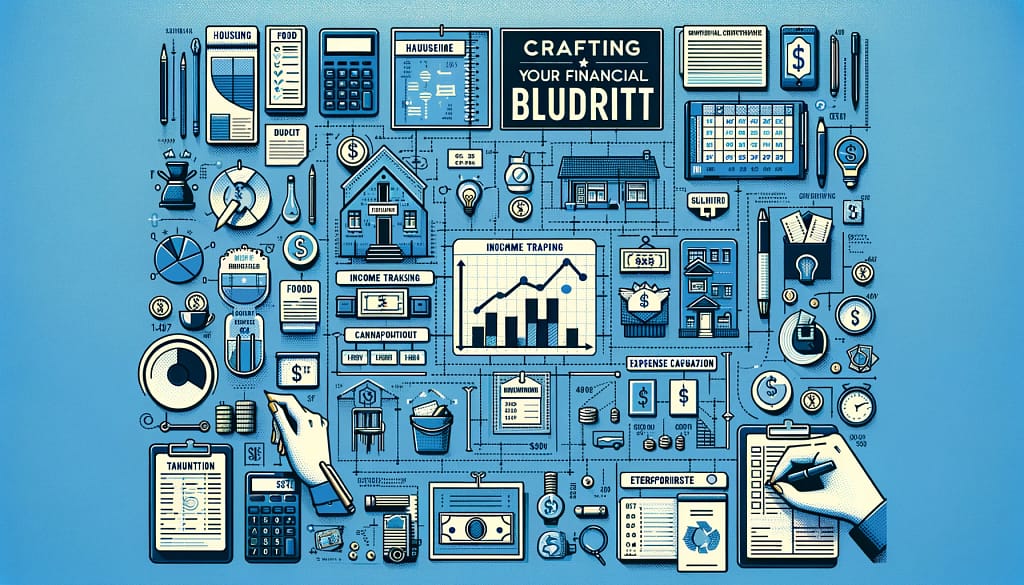In the pursuit of financial stability and freedom, few tools are as essential as a well-crafted budget. A budget serves as a financial blueprint, guiding your spending habits, helping you allocate resources effectively, and empowering you to achieve your short-term and long-term financial goals. Whether you’re aiming to get out of debt, save for a down payment on a home, or plan for a comfortable retirement, a budget is the foundation upon which your financial success can be built.

Why Budgeting Matters
Budgeting is often perceived as a restrictive practice, but in reality, it’s a liberating process that puts you in control of your finances. Without a budget, it’s easy to lose track of where your money is going, leading to overspending, accumulating debt, and missing out on opportunities to save or invest for the future.
By creating a budget, you gain visibility into your income and expenses, enabling you to make informed decisions about how to allocate your resources. This empowers you to prioritize your financial goals, whether it’s paying off debt, building an emergency fund, or saving for retirement.
Step 1: Gather Your Financial Information
The first step in creating a budget is to gather all relevant financial information. This includes:
- Income sources (e.g., employment, freelance work, investment income)
- Fixed expenses (e.g., rent/mortgage, utilities, insurance premiums)
- Variable expenses (e.g., groceries, transportation, entertainment)
- Debt obligations (e.g., credit card balances, student loans, personal loans)
- Investment and savings accounts (e.g., retirement accounts, brokerage accounts, emergency fund)
Collecting this information will provide a comprehensive picture of your financial situation and serve as the foundation for building your budget.
Step 2: Calculate Your Net Income
To accurately allocate your resources, you need to determine your net income, which is the amount of money you have available after accounting for taxes and deductions. If you’re employed, this information can typically be found on your pay stubs. For self-employed individuals or those with multiple income streams, calculating net income may require additional effort.
Step 3: Track Your Expenses
Understanding where your money is going is crucial in creating an effective budget. Start by categorizing your expenses into fixed and variable categories. Fixed expenses are those that remain relatively constant each month, such as rent/mortgage payments, insurance premiums, and loan payments. Variable expenses fluctuate from month to month and may include groceries, entertainment, transportation costs, and discretionary spending.
Consider using budgeting apps, spreadsheets, or good old-fashioned pen and paper to track your expenses for at least one month. This will give you an accurate picture of your spending habits and identify areas where you may be able to cut back or reallocate funds.
Step 4: Set Financial Goals
Budgeting is not just about managing your current expenses; it’s also about working towards your financial goals. Identify your short-term and long-term goals, such as building an emergency fund, paying off debt, saving for a down payment on a home, or preparing for retirement. Prioritize these goals and allocate a portion of your budget towards achieving them.
Step 5: Create Your Budget
With your financial information, net income, expense tracking, and goals in hand, you’re ready to create your budget. There are various budgeting methods to choose from, including:
The 50/30/20 Rule:
- Allocate 50% of your net income towards essential expenses (e.g., housing, utilities, transportation)
- Allocate 30% towards discretionary spending (e.g., entertainment, dining out)
- Allocate 20% towards savings and debt repayment
Zero-Based Budgeting:
- Assign every dollar of your net income a specific purpose (e.g., expenses, savings, debt repayment)
- Ensures that you account for every penny and eliminates wasteful spending
Envelope Budgeting:
- Allocate cash into physical envelopes for different expense categories
- Once an envelope is empty, you can’t spend more in that category for the month
Choose the method that resonates best with your lifestyle and financial goals, and remember, your budget should be flexible enough to accommodate unexpected expenses or changes in your financial situation.
Step 6: Implement, Monitor, and Adjust
Creating a budget is just the first step; consistently implementing and monitoring it is crucial for long-term success. Review your budget regularly and make adjustments as needed. Celebrate small victories, such as paying off a credit card or reaching a savings milestone, to stay motivated.
If you find yourself consistently overspending in certain areas, reevaluate your budget and make necessary adjustments. Remember, a budget is a living document that should evolve as your financial circumstances change.
Crafting a budget is a powerful exercise in taking control of your finances. It requires discipline, commitment, and a willingness to make informed choices about how you allocate your resources. However, the rewards of budgeting are immense – reduced stress, financial stability, and the ability to pursue your dreams with confidence.
Embrace budgeting as a financial blueprint that guides you towards achieving your goals. With patience, perseverance, and a willingness to adapt, you can transform your relationship with money and pave the way for a secure and prosperous future.
FAQs
Creating a budget is crucial for managing your finances effectively, ensuring you live within your means, save for the future, and achieve your financial goals.
Review your budget regularly, ideally monthly, to ensure it aligns with your current financial situation and goals.
Use budgeting apps or spreadsheets to monitor your spending patterns, making it easier to identify areas where adjustments are needed.
Yes, a well-planned budget can help you allocate funds towards paying off debt, reducing financial stress, and improving your overall financial health.
While it’s important to prioritize spending, creating a budget also allows for non-essential expenses, provided they fit within your overall financial plan and goals.